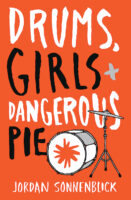Your child may be surprised to know that kids their age are living with serious illness. Sharing these stories allows them to ask questions and develop empathy.
Two articles in Scholastic Choices magazine highlight young adults living with illness. “We Have Invisible Illnesses” profiles students diagnosed with Crohn’s disease, sickle cell disease, Type 1 diabetes, and epilepsy — all incurable conditions. In addition to learning the challenges and stigmas these individuals face, the reader is presented with ways they can be an ally to someone with a lifelong condition.
Much of dealing with illness involves accepting life changes and coping. In “Miya Has Cancer,” readers meet Miya, a Girl Scout who receives a cancer diagnosis just weeks before her troop’s big summer trip to Europe. While her friends travel abroad, Miya undergoes radiation treatment and copes with its side effects, including loss of hair. It takes courage and patience for Miya to pull through, but with the support of family and friends, she completes treatment and regains her confidence. Miya emerges from the summer “more mature, more outgoing...and more motivated,” she says.
Children can be directly impacted by illness even when they are not sick. “Coronavirus Diaries” in the New York Times Upfront, a newsmagazine for high school students published by Scholastic, presents an array of perspectives from children around the country affected by the onset of the coronavirus pandemic in 2020. From New York to Seattle, these students share personal journal entries describing their lockdown experiences, which include concerns about being isolated from friends and community, the safety of family abroad, and of course fear of contracting the virus.
While the article documents a tense time in the nation’s history, it’s a reminder we are connected in many ways and share many of the same hopes and fears. It’s also a great opportunity to encourage your child to start or continue writing in their journal. Doing so has many benefits, like building writing stamina and engaging critical thinking skills. Above all, a journal provides a safe personal space where your child can express themselves.
If your child is an avid fiction reader, they can learn much about illness and healing from characters who face these challenges, especially if the characters are similar in age.
In Drums, Girls, and Dangerous Pie by Jordan Sonnenblick, 13-year-old Steven is having the time of his life taking middle school by storm as the drummer in a band with a crush on a popular girl. But when Steven’s 5-year-old brother is diagnosed with leukemia, all that normalcy changes, and Steven and his family must learn to cope in a year of crisis. It’s a heartwarming — and heartbreaking — tale grounded in the realities of life.
Meanwhile, The Honest Truth by Dan Geimenhart introduces readers to Mark, a dreamer and a poet making plans for big adventures with his dog Beau and best friend Jessie. From the outside, Mark looks like your average kid. But Mark has a terminal illness, one that requires him to be in and out of hospitals undergoing treatment after treatment. One day, Mark runs away from home, intent on escaping his illness and with a mission to climb Washington’s Mount Rainier. As we follow Mark on his incredible journey, we get a glimpse not only of a child’s persistence, but of the insistence of the human spirit in times of hardship.







